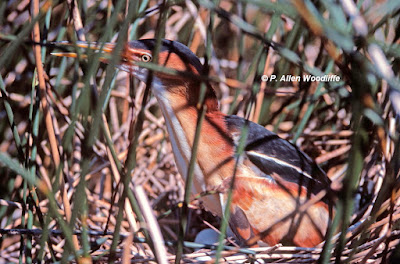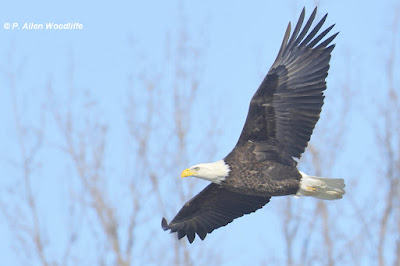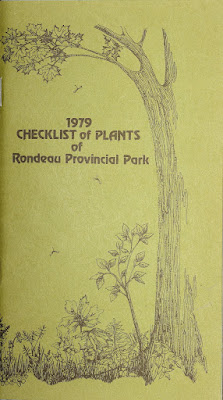As mentioned at the end of the previous post, Marie and I were married on October 16, 1976. After our honeymoon, we lived in Blenheim for the first few months, at my grandparent's place since they were in Florida for the winter. Since I was on a 9-month contract at Rondeau, it meant I had some time off in the winter before getting ready for the 1977 season of hiring staff, etc. We did a bit of traveling, visiting friends in Pembroke, and put some snowshoes to work a bit.

The '77 program was getting off to a good start, with some really talented and capable seasonal staff, some of whom returned from '76, which made my life easier! And it was in the spring of '77 when someone new arrived at Rondeau. It was a fellow by the name of Stafford O. Kratz. He had been in the military during WWII, and was a very talented person, who had lots of experience with wood-working as well as tool and die/machine shop work. And he was also a very energetic and enthusiastic wildlife photographer, especially when it came to finding and photographing bird's nests. As a volunteer, he and his wife Ruth brought their trailer and stayed at the park for several months, and he and I spent a lot of time early in the morning searching for birds and their nests. Using his talents in building things necessary for wildlife photography, he had built photo blinds, the stand structures to raise them to a good level, as well as small punts and boats for getting through the shallow parts of the marsh in search for those species. The punt and boat even had the capability to have a blind on it, so we could photograph right from it.
 |
| Rondeau Marsh |
Stafford and Ruth were at Rondeau for the late spring/early summer of three years, which enabled me to get to areas otherwise difficult to access, and get some very useful photos. Here are a few showing the success of our efforts, the first three were from the punt.
 |
| Least Bittern on nest |
The next one shows a Forster's Tern which was considered quite an unusual species to be nesting in these lower Great Lakes at the time. Nowadays they are more common, especially along the wetlands of the Lake St. Clair area.
 |
| Forster's Tern at nest |
 |
| Black Tern at nest |
 |
| Common Tern on nest |
This next one is of the iconic Prothonotary Warbler. This was photographed in 1977, and I really liked the setting, being in a stub of a Yellow Birch, and the curled bark added to the appeal. This bird was quite cooperative, and this photograph was used for various things, such as the main photo of the park's spring newsletter for several years and also in nature magazines.
Yellow-breasted Chats are quite a rare breeding species in Ontario, especially in the 1970s. Due to some serious blow down of forest trees, the shrubby vegetation complete with lots of raspberry bushes dominated parts of the park, and this pair of chats made use of it. Nesting of chats at Rondeau and elsewhere on the mainland have been very few and far between, but they nest with a bit of regularity on Pelee Island.
On another occasion, we were able to find and photograph the nest of a King Rail! This was in 1978, at a nearby wetland area, and as far as I know, this was the last time an actual nest of a King Rail was found in Ontario. King Rail is a very rare, even endangered species, and although one can find them, or at least hear them, in some of the higher quality wetlands of SW Ontario, finding a nest is almost never done. Due to its endangered status we did not spend much time with this nest or adult. I don't know what the outcome of its nest attempt was.
 |
| King Rail nest |
And on another occasion, using a blind set up in the Rondeau marsh, we were able to photograph Black-crowned Night Herons using a branch as a perch while it was waiting for a frog or fish to be available for a meal. This photo won an award at the local camera club that I was a member of.
Bald Eagles were a provincial rarity at that time. In fact in the very early 1970s, the only active nest on Ontario's Lake Erie shoreline was at Rondeau, and even then although it was active every year, did not always produce young. So when there were one or more nestlings, there were also efforts to band them. An eagle specialist associated with the University of Wisconsin was very actively involved in eagle banding. Since I was the main person who knew how to access the Rondeau nest, I led a group of people across several sloughs to the nest tree.
One of the adult birds was usually in the area, of course, keeping an eye on its young, but never really bothered the crew.
Over the course of the first decade of my career running the program at Rondeau, there were many other things to photograph and document, including many plants. Here are a couple of herps that were always popular to find and photograph.
 |
| Eastern Fox Snake |
 |
| Eastern Spiny Softshell Turtle |
Aside from running the naturalist program, which included arranging for hundreds of students to visit the park and learn about its natural history, I was busy preparing and updating various booklets, including trail guides, newsletters as well as bird and plant lists.
During the time I was still on contract, with no long term certainty of
full-time
employment, I had considered returning to university to pursue a
Master's degree, possibly in the field of aquatic vascular plants. I had
some initial discussions with a university professor I knew from Guelph
with that specialty. He even came to Rondeau on one occasion, and we
spent some time canoeing the Rondeau marsh. It was while we were there,
that he discovered a plant that, in his experience, was the first time
for it in the Lake Erie region. All other locations were farther east somewhere around Lake Ontario.
Unfortunately it wasn't a good discovery, as it is quite invasive.
 |
| European Frog-bit |
On occasion when the International Plowing Match was held in a local county, I was called on to give demonstrations of one sort or another. The photo below was at the plowing match held near St. Thomas in 1985.

Aside from the very busy times running the programs at Rondeau, Marie and I found time to do other things, including moving to Rondeau in 1982. We had been renting a large brick farmhouse a couple of kilometres from the park for about 5 years, but were looking for something we could call ours. This first photo shows our new to us home, a reasonably winterized cottage, from the lake front view, complete with a couple of bird feeders...
...and next is the view from the front door, showing the lake, the grassy beach dunes in winter, and a few deer that probably had come to visit our feeders to see what they could nibble on.

One of the things we really found enjoyable, aside from living year-round in this fantastic natural area, was to listen to an excellent Christian radio station. Since we were right on the Lake Erie shoreline and could almost see across to Ohio, we could receive this station from Cleveland without any problem. It was WCRF, which was part of the Moody Radio Network based out of Chicago. There were some great teaching programs on this station as well as wonderful Christian music. But the one thing I remember most fondly was the program called 'Nightwatch', on every week night from 11-11:30. It was a great way to wind down the day! The host was a fellow by the name of Chuck Wagner. He had a quiet, thoughtful voice full of wisdom, and there were many great soft, inspiring, reverential Christian music pieces to listen to as well. It was definitely a highlight of our time there, to be sure. In fact I was so inspired by the host's voice and music that made the Nightwatch program, when I was asked to give slide shows of nature to church groups, I tried to emulate the Nightwatch style at least as the opening of my program, and apparently with some success as more than one person would come up to me afterwards and ask if I was a listener of Nightwatch. I can still remember the opening to the program even after so many years of not being within radio receiving distance. And in the 35 or more years since, it is no longer part of the radio network's programming.
We also found time to travel, as from 1976 until early 1979, I was still on contract, so I had lots of time off. We traveled west for the most part, as we both had relatives in that direction, and visited lots of places on our meandering routes.
 |
| Yosemite NP |
This next photo shows Rocky Mountain NP in Colorado where we traveled the road that went above the tree line. We got out to hike a bit, but at that altitude, the air was thinner, and we were huffing and puffing in very short order.
 |
| Rocky Mt NP, above the tree line |
 |
| Rocky Mt NP |
 |
| Redwoods NP, CA |
Next is Death Valley NP in California, and this is the lowest point in North America, at an elevation of 282 feet below sea level.
 |
| Elk at Banff NP |
 |
| Chiricahua Mts in Arizona |
 |
| Arches NP, Utah |
We did get to the east coast, but rarely.
 |
| King's Landing |
 |
| A quiet inlet in Nova Scotia |
It was in late 1978 when I learned that my job was going to be made full-time, which I was ecstatic about. The only thing was that I had to apply and compete with others who had similar experience. But as it turned out, my interview was successful and I got the job! Praise the Lord! So in January 1979, I became full time. My job title was: Visitor Services Programmer/Natural Resource Management Specialist! Quite a handle, but I was okay with it. I knew I was going to do more of the usual things, and could plan for even more. And so 1979 through most of 1985 was more of the same, even more intensive, and my plans to pursue a Master's was not going to happen after all.
As part of my new, full-time position, I was tasked with becoming more involved with other provincial parks and nature reserves in the south part of the Chatham District of the Ontario Ministry of Natural Resources (OMNR). This included becoming involved with some life science inventory of Fish Point Prov Nature Reserve and Lighthouse Point Prov NR on Pelee Island. But one of the larger tasks I had was to give a fair bit of time to the needs of management of Ojibway Prairie Prov Nature Reserve (OPPNR), in Windsor. I hadn't had a lot of experience with tallgrass prairie, but more than anyone else within OMNR at the time, and Ojibway Prairie had just recently been acquired and established as a significant nature reserve. So with some investigation, including consulting the staff of the city's Ojibway Nature Centre right across the street from OPPNR, I began my task.
Ojibway Prairie is an incredible natural area, and within the city limits of Windsor. The vegetation is truly impressive, with a multitude of rare and significant plants.
 |
| Dense Blazing-star |
One of the things I was able to do was attend my first North American Prairie Conference in Fargo, North Dakota, in 1984. Marie and I traveled to it, and we explored a few tallgrass prairie sites along the way. This conference, held every two years, was chock full of useful information. Together with whatever else I could find, I produced the first Vegetation Management Plan for OPPNR. This included promoting a regular regime of prescribed burns, as prairie needs them periodically to suppress shrubby invading species.
While some of the upper level OMNR managers were fairly supportive in what I had put together in this vegetation management plan, they wanted a second opinion, so hired a prairie management specialist from Wisconsin to read my plan as well as come to Windsor to see what OPPNR was. The end result was that he endorsed what I had prepared wholeheartedly. My tallgrass prairie future was heading in the right direction, which will be discussed in a future post.
In late 1985, I experienced my next devastating event. It was on a Friday afternoon, when one of the park managers from the Chatham office was at Rondeau, and before he returned, he wanted to inform me of something. I wasn't sure what to expect, but I certainly wasn't prepared for what he told me. First the bad news: my job at Rondeau was declared redundant, which meant it no longer existed. Yikes!!! After that news, he told me that instead the district wanted me to work out of the Chatham office in a larger capacity. Yikes again!! No consultation with me, just a management decision imposed on me.
I had been to the Chatham office on numerous occasions, and while I knew the folks there, and got along fine, I did not see myself as working out of an office of that type. My whole existence was based on being in close touch with the field, exploring and sharing God's creation. Rondeau was one of the best places in Ontario to do that, and I had many plans and ideas to implement in my capacity there. All of those ideas would not come to be, as I was being uprooted and forced to work in an office, an artificial environment. I was devastated. I still remember leaving that meeting, somewhat shocked, and headed to the south end of the park. I often walked along the shoreline and south beach for a multitude of reasons, especially peaceful inspiration, and first off I wanted to get away from what I had just been told about my future. I spent more or less the rest of that afternoon hiking along the shoreline, wondering exactly what to expect and already missing my Rondeau future. I was not enthusiastic about it at all. So going for a long hike (fortunately there were no short piers to walk off of :-), was how I dealt with this unfortunate news, just focusing on the sounds and views of this intriguing part of Rondeau, which I had come to envision my long-term future here. I don't remember specifically praying, but I undoubtedly did.
At any rate, that was how my 1985 ended, and beginning the first of January, I started making the 45 minute commute to the Chatham District Office. And what that resulted in, which was a lot, will be the focus of my next post or two.









































No comments:
Post a Comment